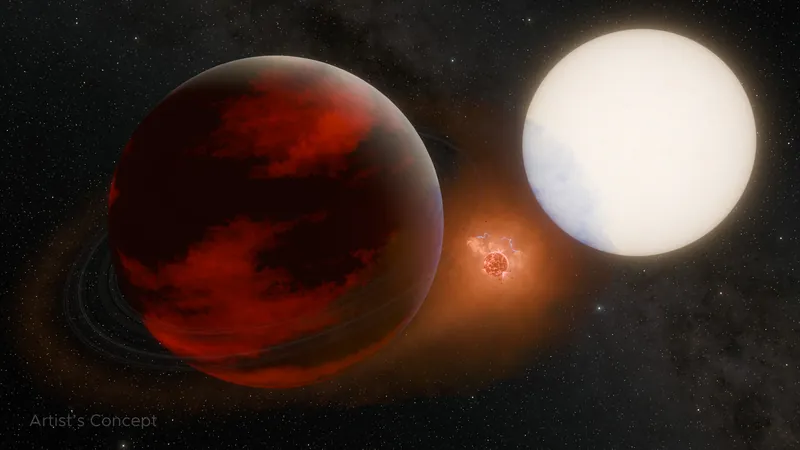
Could a Volcanic Moon Orbiting Distant Planet WASP-49 b Change Our Understanding of Exomoons?
2024-10-10
Author: Kai
Introduction
Exciting news from NASA’s Jet Propulsion Laboratory (JPL) suggests the possibility of a rocky, volcanic moon orbiting an exoplanet located a staggering 635 light-years away from Earth. The findings revolve around a peculiar sodium cloud, which appears to be associated with a Saturn-sized gas giant known as WASP-49 b. The cloud is believed to be slightly misaligned with the planet, hinting at an intriguing source of volcanic activity similar to that of Jupiter's moon Io, known for its intense volcanic output.
The Challenge of Detecting Exomoons
While the existence of exomoons (moons orbiting planets outside our solar system) remains unconfirmed, numerous candidates have surfaced in scientific discussions. The challenge lies in their small size and dimness, making them difficult to detect with current astronomical technology. However, the identification of the sodium cloud around WASP-49 b marks a significant advance in our search for such celestial bodies.
The Discovery of the Sodium Cloud
The sodium cloud itself was first noted back in 2017 by Apurva Oza, a former postdoctoral researcher at JPL and current staff scientist at Caltech. Oza has dedicated extensive research into how volcanic activity could signal the presence of exomoons. Io, our solar system's most active volcanic body, releases vast amounts of sulfur dioxide, sodium, and potassium, creating an expansive halo of gas around Jupiter. This method of detection suggests that similar clouds could exist around distant celestial bodies, indicating the potential presence of unseen exomoons.
Unique Characteristics of the Cloud
Measurements indicate that the sodium cloud surrounding WASP-49 b is not generated by the planet or its host star, as the elements required for its creation exceed their combined outputs. The cloud is estimated to be producing around 220,000 pounds (100,000 kilograms) of sodium per second, raising many questions about its origin.
Challenges in Observing WASP-49 b
Oza and his team faced the challenges of observing the distant system, as the star, planet, and cloud often merged into a single point in the night sky. To gather more data, they utilized advanced observational techniques, revealing several intriguing patterns, including instances when the cloud expanded in size without proximity to the planet—indicative of an independent source.
Evidence Supporting the Exomoon Hypothesis
In their latest study published in the Astrophysical Journal Letters, the researchers detail their findings, outlining that the cloud's rapid movement and sudden growth offer compelling evidence for the existence of an orbiting body—likely a volcanic exomoon. They pointed out that the cloud shifted in direction contrary to established physics if tethered to the planet’s atmosphere.
Modeling the Movement
Julia Seidel, a co-researcher at the European Southern Observatory's Very Large Telescope in Chile, confirmed the cloud's position high above WASP-49 b's atmosphere. By employing computer models, the team illustrated how an exomoon with an eight-hour orbital period could explain the cloud's behavior. The regular orbit of WASP-49 b, taking merely 2.8 days to complete, contrasts strikingly with the irregular appearances and disappearances of the surrounding sodium cloud, supporting the exomoon theory.
Implications of the Findings
As Rosaly Lopes, a planetary geologist at JPL, commented, 'This evidence is very compelling; there is a strong possibility that something other than the planet and star is producing this cloud.' Detecting an exomoon, especially one that exhibits volcanic activity, would be an extraordinary breakthrough in the field of exoplanetary science.
Potential Fate of the Exomoon
However, if such a moon exists, it may face a tumultuous fate. Unlike Earth's volcanoes, which are fueled by internal heat from the planet's core, Io's volcanic activity is driven by Jupiter's immense gravitational pull, a process known as tidal heating. Oza and his team speculate that if WASP-49 b harbors a similar-sized moon, its gradual loss of mass due to gravitational forces may ultimately lead to its disintegration.
Conclusion
'The potential for destruction is significant,' Oza cautioned, 'If there really is a moon there, it will have a very destructive ending.' The implications of such findings could alter our understanding of not just exomoons but the broader landscapes of planetary systems in the universe. Stay tuned for further developments as researchers continue to monitor this distant yet captivating celestial body!


 Brasil (PT)
Brasil (PT)
 Canada (EN)
Canada (EN)
 Chile (ES)
Chile (ES)
 España (ES)
España (ES)
 France (FR)
France (FR)
 Hong Kong (EN)
Hong Kong (EN)
 Italia (IT)
Italia (IT)
 日本 (JA)
日本 (JA)
 Magyarország (HU)
Magyarország (HU)
 Norge (NO)
Norge (NO)
 Polska (PL)
Polska (PL)
 Schweiz (DE)
Schweiz (DE)
 Singapore (EN)
Singapore (EN)
 Sverige (SV)
Sverige (SV)
 Suomi (FI)
Suomi (FI)
 Türkiye (TR)
Türkiye (TR)